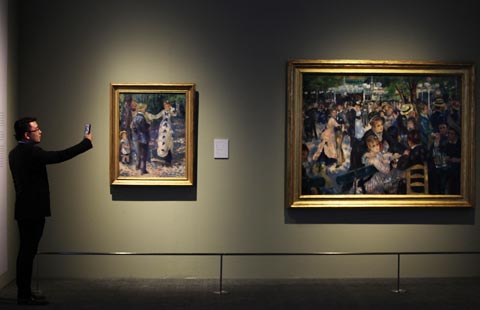 |
|
At the Front of Tian'anmen Gate was created by Sun Zixi in 1964.
|
Some of the exhibits come from the collection of the National Art Museum of China, where the exhibition is held. Most of them are the so-called "history-themed artworks" that are large in size and depict landmark political events and iconic scenes of the nation's social development.
At the Front of Tian'anmen Gate, for example, was painted in 1964 by Sun Zixi when he taught at the school; he later retired as a professor with the CAFA. Sun took the perspective of a photographer to portray three groups of visitors at Tian'anmen Square. He didn't stress the contrast of dark and bright in this oil painting. Instead he drew inspiration from traditional Chinese New Year paintings, or nianhua, to present people's happiness and love for the new republic at that time. The painting is printed on NAMOC's tickets.
The school has been a launchpad for the careers of many of its teachers and students, long before their rise to stardom.
Ai Xuan, a representative of China's realistic painting, graduated from the school in 1967. He spent several years in the Tibetan areas in Sichuan province, during which he was deeply impressed by Tibetan people and their customs. His signature work on show, Norgay, exemplified a turning point in his work after 1982: He stopped sketching landscapes to seek a new form of expression and composition. In this oil painting of 1985, he applied the sentimental and realistic style of Andrew Wyeth to profile a lonely Tibetan man against a snowy white background.

























 Raymond Zhou:
Raymond Zhou: Pauline D Loh:
Pauline D Loh: Hot Pot
Hot Pot Eco China
Eco China China Dream
China Dream China Face
China Face




